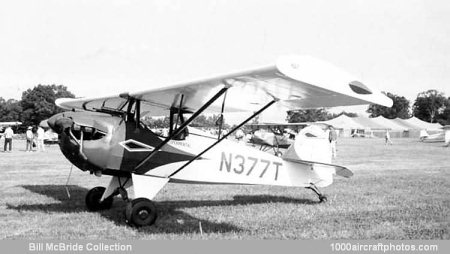STANDARD DATA: Gross wt. 658. Empty wt. 432. Wingspan 23'6". Length 15'1".
PERFORMANCE: Top mph 95. Cruise mph 83. Landing mph 38. Climb rate 450. Ceiling 6,000. Takeoff run 350. Landing roll 400. Range 150. |
The original Termite, designed by Wilbur Smith, was powered by a 36-hp, Aeronca engine, but since then other engines such as the 38-hp Continental and the 65-hp Lycoming have been used. The Termite is a single-seat sporting monoplane with a braced parasol type wing. Its wing structure is built with two wooden spars, an aluminum leading edge, and fabric covering aft of the front spar. The fuselage is an all-wood structure with plywood covering from the rear of the cockpit forward and fabric covering aft. The tail section is also fabric covered. The Termite’s landing gear is a Piper Cub type.
Specifications (Smith Special "Termite")
Data from Sport Aviation
General characteristics
- Capacity: 1
- Length: 16 ft 5 in (5.00 m)
- Wingspan: 23 ft (7.0 m)
- Airfoil: Clark Y
- Empty weight: 394 lb (179 kg)
- Gross weight: 628 lb (285 kg)
- Powerplant: 1 × Aeronca E113-C , 36 hp (27 kW)
- Propellers: 2-bladed
Performance
- Maximum speed: 81 kn; 150 km/h (93 mph)
- Cruise speed: 70 kn; 129 km/h (80 mph)
- Stall speed: 28 kn; 51 km/h (32 mph)
- Service ceiling: 8,000 ft (2,400 m)
- Rate of climb: 450 ft/min (2.3 m/s)
Joseph E. Tyndal of Richmond, Virginia, constructed the pictured N377T (below) which flew for the first time on June 5, 1960. Powered by the 65 hp Lycoming O-145, it differed from the original by having the wing span enlarged by 2 ft 6 in (0.76 m) to 26 ft (7.92 m), endplates, a wheel control instead of a stick, a glass fiber cowling, and two dummy ¾-scale machine guns just in front of the cockpit.
Reportedly also designated Smittys JT-1 Termite, the aircraft's last registered owner was the EAA, its registration being cancelled on July 11, 1984.
The Smith Special also known as "Smitty's Termite" or simply the Smith Termite is a single place home-built aircraft, built primarily out of wood. The exception being the motor mount, struts and landing gear are made out of steel. It was designed to use an engine from an Aeronca aircraft, up to a 65 HP engine.




 Zenair construction manual how to build your own - zodiac ch600
Zenair construction manual how to build your own - zodiac ch600 Zenair zodiac ch 600 plans
Zenair zodiac ch 600 plans Minimax build manual
Minimax build manual Sky pup aircraft construction plans
Sky pup aircraft construction plans Sport aircraft plans aircamper g-1 2 place 24 x 36" 11 prints cruise 95mph
Sport aircraft plans aircamper g-1 2 place 24 x 36" 11 prints cruise 95mph Sport aircraft plans aircamper corvair, cont. supplement update 15 prints
Sport aircraft plans aircamper corvair, cont. supplement update 15 prints